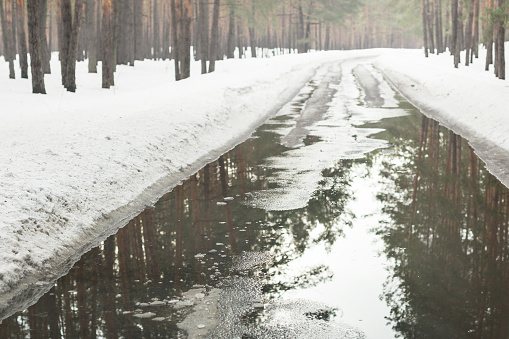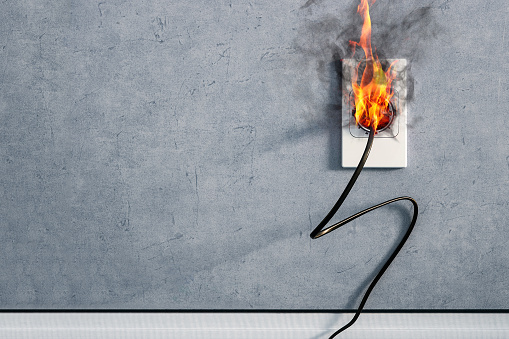When most people hear the word “flood,” they think of rivers overflowing their banks in the springtime and of tropical storms that thrash the Atlantic and Gulf coasts in late summer and early fall. But flooding is a year-round risk that doesn’t end when winter arrives. Across the country, winter is a season of heavy snowfall, rapid snowmelt and intense rainstorms that can lead to flooding — and put property and lives in peril.
Causes of Winter Flooding
Winter flooding is a countrywide risk, but its cause depends on where in the country you live.
Along coastal areas, including the Great Lakes, storms bearing snow, heavy rains and strong winds can cause water levels to rise, which can lead to flooding and beach erosion, especially when the storm’s arrival coincides with a high tide. The East Coast is particularly susceptible, where storm systems known as nor’easters — large, low-pressure areas whose winds come from the northeast — can lead to coastal flooding from the Mid-Atlantic states to the Northeast.
Sudden thaws of heavy snow and ice are another cause of winter flooding. Snowmelts can release huge amounts of water in short periods of time, and frozen ground prevents the melt water from penetrating the ground and being absorbed. As a result, the runoff can cause streams and rivers to overflow their banks. Snowmelt contributes to riverine flooding in many areas, particularly the Northeast, northern Midwest and some areas in the West. It is a common cause of flooding all along the Mississippi River.
Winter is the rainy season for the Western U.S. when Pacific storm systems move inland and bring the potential for heavy rains. Cold-season precipitation is the main supply of water to rivers in the region and for people living in this portion of the U.S. But winter rains can also lead to intense flooding and mudslides that cause millions of dollars in property damage year after year.
Pre-Season Prevention
Flooding is a natural occurrence and to be expected during the winter season. To protect your home, make an annual practice of inspecting these areas of your property and taking preventive action before winter’s extremes of cold, snow and rain are upon you:
- Drainage around your house. Clear window wells and gutters of debris, and be sure downspouts extend at least two to three feet away from the house. Also make sure the landscaping within three feet of your house slopes away from the foundation. This will prevent water from pooling near foundation walls and basement windows.
- Sewer backup valve. Winter storms can flood town and city sewer systems, causing raw sewerage to back up into the homes they service. Installing a sewer backwater valve can minimize the risk of this happening to your property. Be sure to check the valve annually and maintain it in accordance with manufacturer instructions to ensure it will function when you need it most.
- Sump pump. A sump pump can remove water that seeps into your basement during the winter months and any time the weather is stormy. Make sure yours has adequate pumping capacity for the size of your home and has a battery backup that will operate if the power goes out. Test it before winter arrives to make sure it is in good working order.
- Basement walls. Inspect your basement and foundation walls and caulk any cracks on interior walls to prevent water from seeping through. You may also consider using a waterproof sealant on the exterior foundation, especially if your home is susceptible to flooding.
Once the Snow Falls
Newly fallen snow produces roughly one-tenth its volume in water, so every 10 inches of melted snow produces the equivalent of one inch of rain. If you have two or three feet of fallen or drifted snow against your house, a warm day, especially with rain, can release a large volume of water that can affect your foundation and basement.
To prevent snowmelt from flooding your home, clear snow at least one to two feet away from all sides of the foundation, especially near basement windows and around downspouts.
Also remove excess snow from your roof using a roof rake designed specifically for this purpose (a regular rake can damage the roofing materials). Keeping your roof and eaves clear of snow will help prevent ice dams that can form and drive water into your attic, ceilings and walls, sometimes causing extensive damage.
Safety First
Even the most comprehensive preventive measures may not fully protect your home in the event of a winter flood, especially if it’s severe. But your first priority in the event of a flood event should always be your own safety and that of your family.
- If severe flooding is forecasted, be prepared to move to higher ground. Shut off your water, gas, furnace and electrical services before leaving, if you can do so safely. If evacuation orders are issued, follow them to the letter.
- Reenter your home only when it is safe to do so. Get clearance from all utility providers. If the structure has been damaged, also get the okay from your local building inspector.
- Do not enter a flooded basement if the water has risen above the level of electrical outlets, baseboard heaters or furnace, or near your home’s electrical panel. Electricity can move through water and cause a severe electric shock.
Cleanup After a Winter Flood
The longer moisture remains in your home, the more damage it can cause. Begin cleanup as soon as you safely can:
- Wear rubber gloves for protection against possible contaminants.
- Document the damage for insurance purposes. Take pictures or a video of anything that got wet or ruined — from walls and carpeting to furnishings and household items.
- Removed pooled water with a wet vac or mop and bucket.
- Remove water-damaged contents.
- Clean, disinfect and dry every room that was flooded.
- Keep fans running for ventilation.
Flood cleanup can be a daunting task. If the flooding is extensive or you see mold or mildew developing, you might consider bringing in a flood remediation specialist to handle the cleanup for you.
Insurance Protection
According to Floodsmart.gov, just one inch of water in a home can cost more than $25,000 in damage. Insurance can help protect your property from flood damage during the winter and every other season of the year. It’s important to know that your standard homeowners or rental insurance policy does not include this critical protection; flood insurance is available through the National Flood Insurance Program. Typically, there’s a 30-day waiting period after you sign the contract before the policy goes into effect, so be sure to buy flood insurance before the threat of flooding is imminent.
Don’t wait until it’s too late! The Hartford offers National Flood Insurance Program coverage to AARP members. Learn more or get a quote today!






